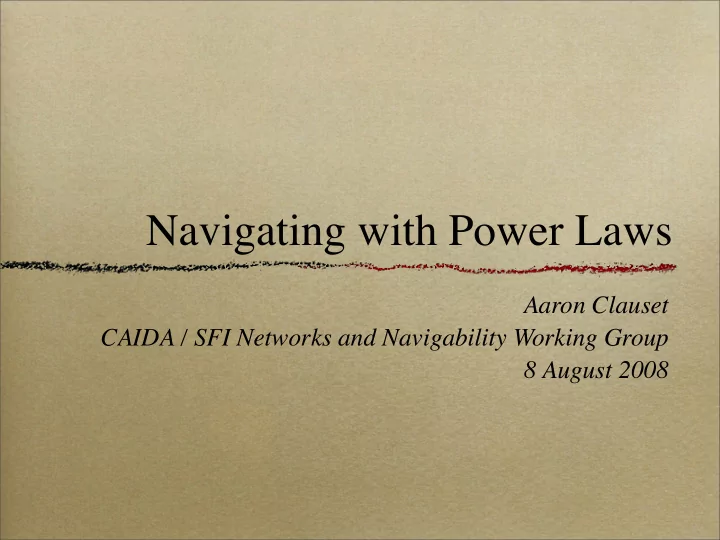

Navigating with Power Laws Aaron Clauset CAIDA / SFI Networks and Navigability Working Group 8 August 2008
Milgram Study (1967) A question of social connectedness • 60 letters sent to Wichita, Kansas • Destination: wife of divinity stud., Cambridge, Ma. • Only 3 arrived • Subsequent studies: mean path length ~6 Discoveries • Surprisingly short paths; “small world” phenom. • Shorts paths are locally discoverable S. Milgram, “The small world problem.” Psychology Today 2 (1967) 60--67.
Watts-Strogatz Model (1998) • Modeled existence of short paths only • diameter log( n ) D.J. Watts and S.H. Strogatz, “Collective dynamics of small-world networks.” Nature 393 (1998) 440-442.
Kleinberg Model (2000) • Model of navigability/search • Lattice + long range links • (Manhattan) distance metric d ( u, v ) = | u − v | log 2 ( n ) • Local (greedy) navigation in ~ steps J. Kleinberg. “The small-world phenomenon: an algorithmic perspective.” Proc. 32nd ACM Symposium on Theory of Computing (2000) 163--170.
An Aside: Finite Size Effects • Simulate Kleinberg graphs with various α ∼ d • Measure mean routing time T • Find severe finite size effects α T opt � = d d = 1 e.g., for A α T opt ( n ) = 1 − log 2 ( n ) • Keep this in mind for later
Simulation Results 140 α opt ~0.900 n~2*10 5 α opt ~0.911 n~5*10 5 α opt ~0.921 n~1*10 6 130 α opt ~0.928 n~2*10 6 mean routing time, T 120 110 100 90 80 0.8 0.825 0.85 0.875 0.9 0.925 0.95 0.975 1 powerlaw exponent, α
Convergence 0 10 1 − α (n) data − 2 (n) 1 − 2.8499log 10 1 − α opt − 1 10 − 2 10 1 2 3 4 5 6 7 10 10 10 10 10 10 10 network size, n
Not a new result 20,000 x 20,000 lattice J. Kleinberg, “Navigation in a small world.” Nature 406 (2000) 845.
Origins of Navigability Observation • Real networks often locally navigable e.g., social network, world wide web Idea • Distributed changes to topology • Greedy changes to improve local navigability • web surfers on network of home pages • links changed based on speed of surfing
Clauset/Moore Model (2003) b u a v • Same network as Kleinberg • Dynamic, greedy rewiring process • Global attractor for link-length distribution P ( � ) → � − α rewired α rewired ∼ d • Gives routing time T ∼ [log( n )] 2
Dynamics ( x, y ) d = 1 1. choose random pair (for ) [1 , d ( x, y )] T t 2. choose random tolerance on T r ≥ T t 3. if routing time , become frustrated 4. if frustrated , change random long-range link to have T t length
Simulation Results Initial Conditions P ( � ) ∼ � −∞ All self-loops, i.e., Stop Criteria When link-length distribution stabilizes
Rewired Link-Lengths 5 10 f(l) = O(l − 0.7789 ) n ≈ 10 3 f(l) = O(l − 0.8239 ) n ≈ 10 4 f(l) = O(l − 0.8454 ) n ≈ 10 5 f(l) = O(l − 0.8760 ) n ≈ 10 6 4 10 3 10 frequency 2 10 1 10 0 10 1 4 19 84 369 1619 7098 31119 136423 598068 link − length (log − binned), l
Routing Times • Measure mean routing times after stabilization • Fast routing times T ∼ [log( n )] α Topt • Recall that (finite size effects) α T opt ∼ d
Routing Times 150 T(n) for α =d T(n) for α opt , α rewired T(n) =4.1log 2 (n) − 7.39log(n) +6.08 125 mean routing time, T 100 75 50 25 0 1 2 3 4 5 6 7 10 10 10 10 10 10 10 network size, n
How long until navigable? • Let rewiring time be rewiring trials until τ ( n ) T rewired ≤ 1 . 01 · T opt • grows as a low-order polynomial τ ( n ) τ ( n ) ∼ n 1 . 77
Time to Navigability 4 10 τ (n) data τ (n) =9+0.0304n 0.77 3 rewiring time, τ (trials per node) 10 2 10 1 10 0 10 1 2 3 4 5 6 7 10 10 10 10 10 10 10 network size, n
Global Attractor Initial Condition • Link-length distribution P ( � ) ∼ � − α 0 • Measure as function of α rewired α 0 • Rewired distribution (eventually) independent of initial condition
Independence 1 0.95 0.9 rewired exponent, α rewired 0.85 0.8 0.75 0.7 τ =75 τ =150 0.65 τ =300 τ =500 0.6 0 0.2 0.4 0.6 0.8 1 1.2 1.4 1.6 1.8 initial exponent, α 0
Analytics • Distribution of tolerances T t P ( T t ) = log n − log T t n − 1 − log n • Otherwise, we don’t know much • If , then E [new length] = E [old length] α = d • What is ? P (frustrated | d ( u, v ))
Thoughts • Navigability can come from distributed behavior • Natural/intuitive mechanism • Process is adaptive to changes in size, etc. • Analytics hard (full-history problems) • Power laws emerge spontaneously - why? • How does destination popularity effect rewired topol. • Preprint at cond-mat/0309415
Recommend
More recommend